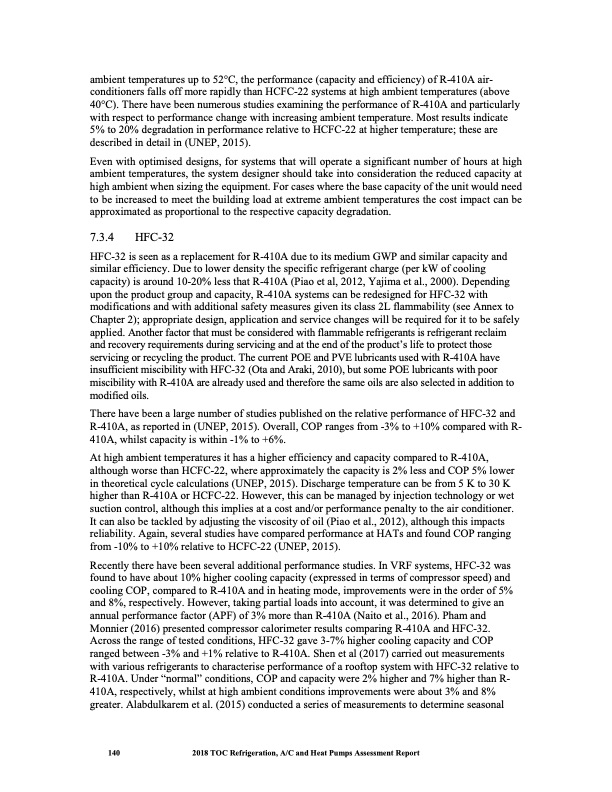
PDF Publication Title:
Text from PDF Page: 153
ambient temperatures up to 52°C, the performance (capacity and efficiency) of R-410A air- conditioners falls off more rapidly than HCFC-22 systems at high ambient temperatures (above 40°C). There have been numerous studies examining the performance of R-410A and particularly with respect to performance change with increasing ambient temperature. Most results indicate 5% to 20% degradation in performance relative to HCFC-22 at higher temperature; these are described in detail in (UNEP, 2015). Even with optimised designs, for systems that will operate a significant number of hours at high ambient temperatures, the system designer should take into consideration the reduced capacity at high ambient when sizing the equipment. For cases where the base capacity of the unit would need to be increased to meet the building load at extreme ambient temperatures the cost impact can be approximated as proportional to the respective capacity degradation. 7.3.4 HFC-32 HFC-32 is seen as a replacement for R-410A due to its medium GWP and similar capacity and similar efficiency. Due to lower density the specific refrigerant charge (per kW of cooling capacity) is around 10-20% less that R-410A (Piao et al, 2012, Yajima et al., 2000). Depending upon the product group and capacity, R-410A systems can be redesigned for HFC-32 with modifications and with additional safety measures given its class 2L flammability (see Annex to Chapter 2); appropriate design, application and service changes will be required for it to be safely applied. Another factor that must be considered with flammable refrigerants is refrigerant reclaim and recovery requirements during servicing and at the end of the product’s life to protect those servicing or recycling the product. The current POE and PVE lubricants used with R-410A have insufficient miscibility with HFC-32 (Ota and Araki, 2010), but some POE lubricants with poor miscibility with R-410A are already used and therefore the same oils are also selected in addition to modified oils. There have been a large number of studies published on the relative performance of HFC-32 and R-410A, as reported in (UNEP, 2015). Overall, COP ranges from -3% to +10% compared with R- 410A, whilst capacity is within -1% to +6%. At high ambient temperatures it has a higher efficiency and capacity compared to R-410A, although worse than HCFC-22, where approximately the capacity is 2% less and COP 5% lower in theoretical cycle calculations (UNEP, 2015). Discharge temperature can be from 5 K to 30 K higher than R-410A or HCFC-22. However, this can be managed by injection technology or wet suction control, although this implies at a cost and/or performance penalty to the air conditioner. It can also be tackled by adjusting the viscosity of oil (Piao et al., 2012), although this impacts reliability. Again, several studies have compared performance at HATs and found COP ranging from -10% to +10% relative to HCFC-22 (UNEP, 2015). Recently there have been several additional performance studies. In VRF systems, HFC-32 was found to have about 10% higher cooling capacity (expressed in terms of compressor speed) and cooling COP, compared to R-410A and in heating mode, improvements were in the order of 5% and 8%, respectively. However, taking partial loads into account, it was determined to give an annual performance factor (APF) of 3% more than R-410A (Naito et al., 2016). Pham and Monnier (2016) presented compressor calorimeter results comparing R-410A and HFC-32. Across the range of tested conditions, HFC-32 gave 3-7% higher cooling capacity and COP ranged between -3% and +1% relative to R-410A. Shen et al (2017) carried out measurements with various refrigerants to characterise performance of a rooftop system with HFC-32 relative to R-410A. Under “normal” conditions, COP and capacity were 2% higher and 7% higher than R- 410A, respectively, whilst at high ambient conditions improvements were about 3% and 8% greater. Alabdulkarem et al. (2015) conducted a series of measurements to determine seasonal 140 2018 TOC Refrigeration, A/C and Heat Pumps Assessment ReportPDF Image | Heat Pumps Technical Options

PDF Search Title:
Heat Pumps Technical OptionsOriginal File Name Searched:
RTOC-assessment-report-2018_0.pdfDIY PDF Search: Google It | Yahoo | Bing
CO2 Organic Rankine Cycle Experimenter Platform The supercritical CO2 phase change system is both a heat pump and organic rankine cycle which can be used for those purposes and as a supercritical extractor for advanced subcritical and supercritical extraction technology. Uses include producing nanoparticles, precious metal CO2 extraction, lithium battery recycling, and other applications... More Info
Heat Pumps CO2 ORC Heat Pump System Platform More Info
| CONTACT TEL: 608-238-6001 Email: greg@infinityturbine.com | RSS | AMP |